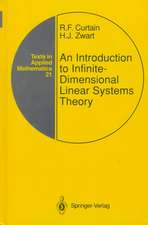An Introduction to Sequential Dynamical Systems: Universitext
Autor Henning Mortveit, Christian Reidysen Limba Engleză Paperback – 31 oct 2007
This text is the first to provide a comprehensive introduction to SDS. Driven by numerous examples and thought-provoking problems, the presentation offers good foundational material on finite discrete dynamical systems which leads systematically to an introduction of SDS. Techniques from combinatorics, algebra and graph theory are used to study a broad range of topics, including reversibility, the structure of fixed points and periodic orbits, equivalence, morphisms and reduction. Unlike other books that concentrate on determining the structure of various networks, this book investigates the dynamics over these networks by focusing on how the underlying graph structure influences the properties of the associated dynamical system.
This book is aimed at graduate students and researchers in discrete mathematics, dynamical systems theory, theoretical computer science, and systems engineering who are interested in analysis and modeling of network dynamics as well as their computer simulations. Prerequisites include knowledge of calculus and basic discrete mathematics. Some computer experience and familiarity with elementary differential equations and dynamical systems are helpful but not necessary.
Din seria Universitext
- 13%
 Preț: 353.48 lei
Preț: 353.48 lei -
 Preț: 418.67 lei
Preț: 418.67 lei -
 Preț: 465.61 lei
Preț: 465.61 lei -
 Preț: 371.98 lei
Preț: 371.98 lei - 17%
 Preț: 394.41 lei
Preț: 394.41 lei -
 Preț: 356.77 lei
Preț: 356.77 lei - 17%
 Preț: 364.56 lei
Preț: 364.56 lei - 15%
 Preț: 543.75 lei
Preț: 543.75 lei - 15%
 Preț: 497.21 lei
Preț: 497.21 lei -
 Preț: 634.38 lei
Preț: 634.38 lei -
 Preț: 396.53 lei
Preț: 396.53 lei - 17%
 Preț: 427.68 lei
Preț: 427.68 lei - 13%
 Preț: 355.51 lei
Preț: 355.51 lei -
 Preț: 360.07 lei
Preț: 360.07 lei - 17%
 Preț: 365.34 lei
Preț: 365.34 lei -
 Preț: 358.44 lei
Preț: 358.44 lei - 15%
 Preț: 553.33 lei
Preț: 553.33 lei - 17%
 Preț: 364.81 lei
Preț: 364.81 lei -
 Preț: 673.45 lei
Preț: 673.45 lei - 15%
 Preț: 509.58 lei
Preț: 509.58 lei - 17%
 Preț: 427.32 lei
Preț: 427.32 lei - 17%
 Preț: 426.76 lei
Preț: 426.76 lei - 8%
 Preț: 495.43 lei
Preț: 495.43 lei - 20%
 Preț: 569.54 lei
Preț: 569.54 lei - 19%
 Preț: 429.21 lei
Preț: 429.21 lei - 17%
 Preț: 369.06 lei
Preț: 369.06 lei - 15%
 Preț: 737.46 lei
Preț: 737.46 lei - 13%
 Preț: 389.95 lei
Preț: 389.95 lei -
 Preț: 487.96 lei
Preț: 487.96 lei - 20%
 Preț: 628.22 lei
Preț: 628.22 lei -
 Preț: 372.86 lei
Preț: 372.86 lei -
 Preț: 319.07 lei
Preț: 319.07 lei -
 Preț: 379.86 lei
Preț: 379.86 lei -
 Preț: 445.88 lei
Preț: 445.88 lei -
 Preț: 382.36 lei
Preț: 382.36 lei - 15%
 Preț: 533.72 lei
Preț: 533.72 lei - 15%
 Preț: 496.02 lei
Preț: 496.02 lei - 15%
 Preț: 474.82 lei
Preț: 474.82 lei -
 Preț: 389.70 lei
Preț: 389.70 lei -
 Preț: 484.08 lei
Preț: 484.08 lei - 15%
 Preț: 469.41 lei
Preț: 469.41 lei - 15%
 Preț: 643.48 lei
Preț: 643.48 lei -
 Preț: 415.02 lei
Preț: 415.02 lei - 15%
 Preț: 602.25 lei
Preț: 602.25 lei - 20%
 Preț: 510.24 lei
Preț: 510.24 lei - 15%
 Preț: 588.37 lei
Preț: 588.37 lei -
 Preț: 381.59 lei
Preț: 381.59 lei -
 Preț: 489.87 lei
Preț: 489.87 lei -
 Preț: 493.89 lei
Preț: 493.89 lei
Preț: 386.61 lei
Nou
Puncte Express: 580
Preț estimativ în valută:
73.98€ • 77.45$ • 61.21£
73.98€ • 77.45$ • 61.21£
Carte tipărită la comandă
Livrare economică 05-19 aprilie
Preluare comenzi: 021 569.72.76
Specificații
ISBN-13: 9780387306544
ISBN-10: 0387306544
Pagini: 248
Ilustrații: XII, 248 p. 73 illus.
Dimensiuni: 155 x 235 x 12 mm
Greutate: 0.38 kg
Ediția:2008
Editura: Springer Us
Colecția Springer
Seria Universitext
Locul publicării:New York, NY, United States
ISBN-10: 0387306544
Pagini: 248
Ilustrații: XII, 248 p. 73 illus.
Dimensiuni: 155 x 235 x 12 mm
Greutate: 0.38 kg
Ediția:2008
Editura: Springer Us
Colecția Springer
Seria Universitext
Locul publicării:New York, NY, United States
Public țintă
ResearchCuprins
What is a Sequential Dynamical System?.- A Comparative Study.- Graphs, Groups, and Dynamical Systems.- Sequential Dynamical Systems over Permutations.- Phase-Space Structure of SDS and Special Systems.- Graphs, Groups, and SDS.- Combinatorics of Sequential Dynamical Systems over Words.- Outlook.
Recenzii
From the reviews:
"By a sequential dynamical system (SDS), Mortveit (Virginia Polytechnic Institute and State Univ.) and Reidys (Nankai Univ., China) mean a certain type of mathematical model. … Summing Up: Recommended. Upper-division undergraduate through professional collections." (D. V. Feldman, CHOICE, Vol. 45 (10), June, 2008)
"A comprehensive introduction to sequential dynamical systems (SDS), i.e. a class of dynamical systems defined over graphs where the dynamics arise through functional composition of local dynamics. … The book will be useful to graduate students and researches in discrete mathematics, dynamical systems, theoretical computer science, and systems engineering … ." (Georgy Osipenko, Zentralblatt MATH, Vol. 1135 (13), 2008)
"By a sequential dynamical system (SDS), Mortveit (Virginia Polytechnic Institute and State Univ.) and Reidys (Nankai Univ., China) mean a certain type of mathematical model. … Summing Up: Recommended. Upper-division undergraduate through professional collections." (D. V. Feldman, CHOICE, Vol. 45 (10), June, 2008)
"A comprehensive introduction to sequential dynamical systems (SDS), i.e. a class of dynamical systems defined over graphs where the dynamics arise through functional composition of local dynamics. … The book will be useful to graduate students and researches in discrete mathematics, dynamical systems, theoretical computer science, and systems engineering … ." (Georgy Osipenko, Zentralblatt MATH, Vol. 1135 (13), 2008)
Textul de pe ultima copertă
Sequential Dynamical Systems (SDS) are a class of discrete dynamical systems which significantly generalize many aspects of systems such as cellular automata, and provide a framework for studying dynamical processes over graphs.
This text is the first to provide a comprehensive introduction to SDS. Driven by numerous examples and thought-provoking problems, the presentation offers good foundational material on finite discrete dynamical systems which leads systematically to an introduction of SDS. Techniques from combinatorics, algebra and graph theory are used to study a broad range of topics, including reversibility, the structure of fixed points and periodic orbits, equivalence, morphisms and reduction. Unlike other books that concentrate on determining the structure of various networks, this book investigates the dynamics over these networks by focusing on how the underlying graph structure influences the properties of the associated dynamical system.
This book is aimed at graduate students and researchers in discrete mathematics, dynamical systems theory, theoretical computer science, and systems engineering who are interested in analysis and modeling of network dynamics as well as their computer simulations. Prerequisites include knowledge of calculus and basic discrete mathematics. Some computer experience and familiarity with elementary differential equations and dynamical systems are helpful but not necessary.
This text is the first to provide a comprehensive introduction to SDS. Driven by numerous examples and thought-provoking problems, the presentation offers good foundational material on finite discrete dynamical systems which leads systematically to an introduction of SDS. Techniques from combinatorics, algebra and graph theory are used to study a broad range of topics, including reversibility, the structure of fixed points and periodic orbits, equivalence, morphisms and reduction. Unlike other books that concentrate on determining the structure of various networks, this book investigates the dynamics over these networks by focusing on how the underlying graph structure influences the properties of the associated dynamical system.
This book is aimed at graduate students and researchers in discrete mathematics, dynamical systems theory, theoretical computer science, and systems engineering who are interested in analysis and modeling of network dynamics as well as their computer simulations. Prerequisites include knowledge of calculus and basic discrete mathematics. Some computer experience and familiarity with elementary differential equations and dynamical systems are helpful but not necessary.
Caracteristici
First graduate textbook on Sequential Dynamical Systems Details seminal SDS research toward a general theory of discrete computer simulations, with applications developed in government labs Versatile interdisciplinary textbook relevant to applied mathematicians and computer scientists alike Includes supplementary material: sn.pub/extras
















